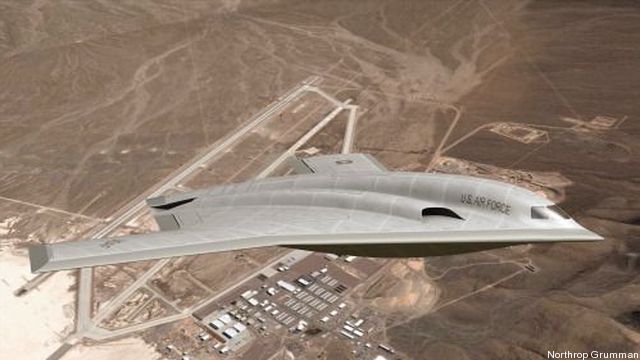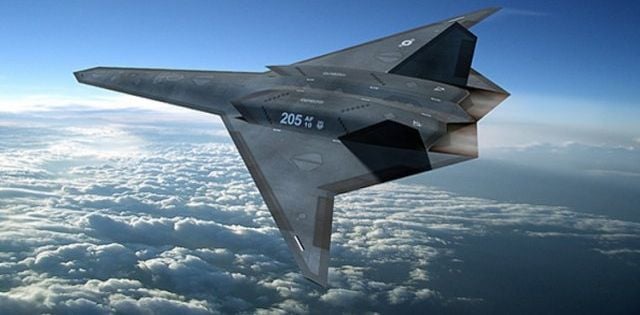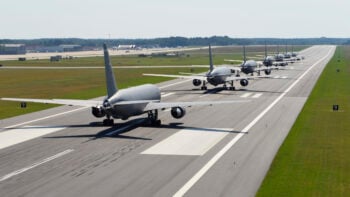UPDATED: AFCoS Gen. Welsh On Stealth Industrial Base; A PIlot Comments
WASHINGTON: When the Pentagon picks the winner of the Long Range Strike Bomber (LRSB) contest in the next few months, it faces an interesting choice. It could give Lockheed Martin — which is doing the design work for the Boeing-Lockheed team — almost all of the country’s advanced stealth design work. Or it could maintain the status quo, in which the entire stealth bomber fleet is made by Northrop Grumman.
It’s a really important competition, arguably more important for the industrial base and the American people than the incredibly painful and problem-plagued tanker program.
UPDATE BEGINS: Air Force Chief of Staff Gen. Mark Welsh offered very little of substance about the industrial base issue when I asked him about it this morning at an Air Force Association breakfast, beyond agreeing that industrial base issues have “to be at the top of the peak” and that “there’s a lot of focus on that area.” Welsh was honest enough to ask: “Was that fuzzy enough for you?” It was hard to tell whether he was being very careful because of the ongoing competition or because much of an honest answer would quickly drift into the classified realm. ENDS
“There hasn’t been a new combat aircraft development contract in over a decade, and another decade will almost certainly pass before we see the next one,” noted Richard Aboulafia, a top aerospace analyst at the Teal Group, in an article for Forbes earlier this week. “In other words, there are three primes involved in the LRS-B competition, and only two will likely survive to compete for future combat aircraft programs. Thanks to F-35, Lockheed Martin doesn’t need to worry about staying in the combat aircraft business. But for the other two companies, a loss means they will likely exit the industry. The loser won’t be around to compete for the next generation of fighter designs, which should enter service around 2030.”
The argument for the Boeing-led team rests principally on the fact that Boeing often can produce large numbers of large aircraft on time and at a reasonable cost. But Boeing’s record on commercial aircraft is mixed — 777 vs. 787 — and it’s encountering difficulties with the KC-46, a commercial aircraft that’s being modified for military tanker use.
“When they get it right, when they do large volume aircraft, they do it better than anyone,” Aboulafia told me yesterday evening. “But you also have a company that stumbles pretty badly,” offering as an example the Wedgetail, and, to a lesser degree, the KC-46. Both are weapons based on commercial airframes, supposedly eliminating many of the usual problems that surface when a new military aircraft is designed and built.
Of course, if the Boeing-led team loses, the US would “lose important production capabilities” and the jobs that go with them. “On the other hand,” Aboulafia wrote earlier this week, “if Lockheed Martin and Boeing win, there would be just one combat aircraft design team left, Lockheed Martin. Northrop Grumman’s exit as a source of new combat aircraft designs would be just as painful.”
Frank Kendall, the Pentagon top’s buyer, said earlier this month that industrial base considerations would not play a major role in selecting the winner. The winner, he said, would be selected “on the merits. By the rules of the source selection.” Since Kendall has made a point of singling out design teams as jewels worth protecting, it seems a bit rich for him to make this claim, but he’s clearly sending a signal.
The Air Force’s commitment to a set price of $550 million (in then-year dollars) each for the 100 or so bombers — and another $20 billion or more for the research and development phase — would seem to increase the likelihood that would tilt the hand to Boeing since building the planes would be more about production than innovation.
And there’s the fact that Boeing and Lockheed will have enormous clout protecting the program on the Hill because of their size. But the companies will also be deeply conflicted when the budget showdowns start. Does Lockheed give up some F-35s to pay for the LRSB when the crunch comes in 2020? Does Boeing yield on the KC-46? Both scenarios are unlikely and would seem to argue for a single committed advocate for the plane: that would be Northrop Grumman.
On the issue of maintaining Northrop’s stealthy aircraft design team to ensure the country isn’t left only with Lockheed’s, Aboulafia didn’t dismiss it, but he did say “there are ways in the black world of keeping someone in the design world.” While Northrop wouldn’t build the bomber if it didn’t get the contract, the Pentagon could keep its highly skilled and intelligence workers going on programs that are so highly classified they don’t appear in the budget.
A pilot familiar with stealth bombers agreed, noting that: “there are fundamental design differences between fighter and bomber stealth aircraft. They each utilize stealth in very different ways. Maintaining expertise in both is something we need to consider for the long term. I think in today’s world that can happen independent of the number of companies.”
The pilot argues that times have changed in defense acquisition. In those good old days, “companies could easily design/build/test/discard prototypes in very short timeframes due to cost, ease of production, and materials requirements. Furthermore, the level of engineering involved was nothing like what we face today. I would argue the days of aircraft design competitions are all but over. To harken back to those days is unrealistic given the realities of the technology and materials in the modern world.”
On the other hand, the B-2 pilot is a bit worried for the longer term, saying “it would serve us well to have design and production capability survive in multiple companies. It’s hard to imagine a world like that given our current strength, but history has a way of humbling the greatest of powers!”
Aboulafia also thinks Northrop’s expertise gained from building and maintaining the B-2 matters. “I think one of Northrop’s strongest points is, hey, this defines what we do. And we’re it.”
In the end, Aboulafia doesn’t really have a gut feeling — or one based on facts — about who will win the bomber contract.
If Boeing wins, Lockheed will do the critical design work and will almost certainly not share that intellectual property with Boeing. The Boeing-Lockheed team has the aircraft production credentials and the power to send dozens of lobbyists and carloads of cash to Capitol Hill to ensure the program’s safety in the face of the coming budget crunch.
If Northrop wins, the nation has two design teams able to work on stealthy aircraft and it gets the incumbent. While space is a different realm in terms of engineering and industrial base, it shares elements of requiring the most advanced engineering talent. The last time Boeing won a huge contract in an area in which it didn’t have much experience, advanced intelligence satellites, the country suffered years of cost overruns, busted schedules and got, by all accounts, a largely failed program, known as the Future Imagery Architecture. Let’s all just hope the selection committee gets this one right.
From F-16s to NATO, Argentina’s moves tilt West, but ties to China to last
There are flashpoints to watch as Argentina navigates its future between the polar attractions of Washington and Beijing, including future defense deals and a deep space facility.





























